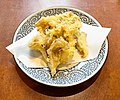Grifola frondosa
Grias cauliflora, also known as the anchovy pear, is a species of flowering plant in the family Lecythidaceae. It is native to the tropical rainforests of South America, particularly in the countries of Brazil, Colombia, and Venezuela.
Description[edit]
The Grias cauliflora is a large evergreen tree that can reach up to 20 meters in height. It has a straight trunk with a dense, rounded crown. The leaves are simple, alternate, and oblong, with a glossy dark green upper surface and a lighter underside. The flowers are large, showy, and fragrant, with numerous stamens and a single pistil. The fruit is a large, fleshy drupe, similar in appearance to an avocado, and contains a single large seed.
Cultivation and Uses[edit]
Grias cauliflora is cultivated for its edible fruit, which is consumed both fresh and processed. The fruit has a unique flavor, described as a mix between an avocado and an anchovy, hence the common name "anchovy pear". The fruit is also used in traditional medicine for the treatment of various ailments, including digestive disorders and skin conditions.
In addition to its culinary and medicinal uses, Grias cauliflora is also grown as an ornamental tree for its attractive foliage and flowers. It is a popular choice for tropical gardens and parks, and is also used in reforestation projects due to its fast growth and adaptability to different soil types.
Conservation Status[edit]
Despite its wide distribution and cultivation, Grias cauliflora is considered a threatened species in some parts of its native range due to deforestation and habitat loss. Efforts are being made to conserve the species through in situ and ex situ conservation strategies, including the establishment of protected areas and seed banking.
See Also[edit]
References[edit]
<references />
![]()
This flora-related article is a stub. You can help WikiMD by expanding it.
This <a href="/wiki/South_America" title="South America">South America</a>-related article is a <a href="/wiki/Stub" title="Stub">stub</a>. You can help <a href="/wiki/WikiMD" title="WikiMD">WikiMD</a> by expanding it.
-
Grifola frondosa
-
Grifola frondosa
-
Grifola frondosa cross-section
-
Grifola frondosa
-
Maitake Mushroom Tempura
-
Maitake rice
-
Maitake soba noodle
Ad. Transform your life with W8MD's Budget GLP-1 injections from $75


W8MD offers a medical weight loss program to lose weight in Philadelphia. Our physician-supervised medical weight loss provides:
- Weight loss injections in NYC (generic and brand names):
- Zepbound / Mounjaro, Wegovy / Ozempic, Saxenda
- Most insurances accepted or discounted self-pay rates. We will obtain insurance prior authorizations if needed.
- Generic GLP1 weight loss injections from $75 for the starting dose.
- Also offer prescription weight loss medications including Phentermine, Qsymia, Diethylpropion, Contrave etc.
NYC weight loss doctor appointmentsNYC weight loss doctor appointments
Start your NYC weight loss journey today at our NYC medical weight loss and Philadelphia medical weight loss clinics.
- Call 718-946-5500 to lose weight in NYC or for medical weight loss in Philadelphia 215-676-2334.
- Tags:NYC medical weight loss, Philadelphia lose weight Zepbound NYC, Budget GLP1 weight loss injections, Wegovy Philadelphia, Wegovy NYC, Philadelphia medical weight loss, Brookly weight loss and Wegovy NYC
|
WikiMD's Wellness Encyclopedia |
| Let Food Be Thy Medicine Medicine Thy Food - Hippocrates |
Medical Disclaimer: WikiMD is not a substitute for professional medical advice. The information on WikiMD is provided as an information resource only, may be incorrect, outdated or misleading, and is not to be used or relied on for any diagnostic or treatment purposes. Please consult your health care provider before making any healthcare decisions or for guidance about a specific medical condition. WikiMD expressly disclaims responsibility, and shall have no liability, for any damages, loss, injury, or liability whatsoever suffered as a result of your reliance on the information contained in this site. By visiting this site you agree to the foregoing terms and conditions, which may from time to time be changed or supplemented by WikiMD. If you do not agree to the foregoing terms and conditions, you should not enter or use this site. See full disclaimer.
Credits:Most images are courtesy of Wikimedia commons, and templates, categories Wikipedia, licensed under CC BY SA or similar.
Translate this page: - East Asian
中文,
日本,
한국어,
South Asian
हिन्दी,
தமிழ்,
తెలుగు,
Urdu,
ಕನ್ನಡ,
Southeast Asian
Indonesian,
Vietnamese,
Thai,
မြန်မာဘာသာ,
বাংলা
European
español,
Deutsch,
français,
Greek,
português do Brasil,
polski,
română,
русский,
Nederlands,
norsk,
svenska,
suomi,
Italian
Middle Eastern & African
عربى,
Turkish,
Persian,
Hebrew,
Afrikaans,
isiZulu,
Kiswahili,
Other
Bulgarian,
Hungarian,
Czech,
Swedish,
മലയാളം,
मराठी,
ਪੰਜਾਬੀ,
ગુજરાતી,
Portuguese,
Ukrainian







